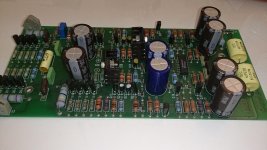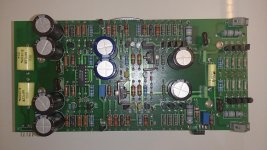I have a Krell KAV-250A Power Amp and have some questions for the owners and gurus out there.
1) When i power ON the amp, the large relay clicks on immediately and so does the blue LED. Is this normal or shouldn't there be a delay ? If it is not OK, what should i check ?
2) When i power ON the amp, there is a slight pop sound on the speakers. Is this normal ?
3) There is a large relay on the power supply board. Is this suppose to be for the power on delay ? Does anyone have the power board circuit diagram ?
4) When pressing the button to power OFF the amp, i need to press it several times before it powers off. Powering ON is no problem and one shot. I tested the switch and the contact seems OK. What else could be wrong ?
5) On the speaker output, there is a 50mV DC on both channels. Is this within the normal specs ?
6) How should i check the bias of the amp and what is the correct bias value ?
7) How do i test the amp using a scope to ensure that everything is working normally ? What signal voltage should i apply to the input and can i safely test the output without any load ?
8) If a single pair of the 5 pairs of output transistor blows (open circuit), will it be noticeable by just hearing, if the amp is not driven hard? Can this be picked up using a scope ?
Does anyone have the full circuit diagram or the service manual for this amp ?
1) When i power ON the amp, the large relay clicks on immediately and so does the blue LED. Is this normal or shouldn't there be a delay ? If it is not OK, what should i check ?
2) When i power ON the amp, there is a slight pop sound on the speakers. Is this normal ?
3) There is a large relay on the power supply board. Is this suppose to be for the power on delay ? Does anyone have the power board circuit diagram ?
4) When pressing the button to power OFF the amp, i need to press it several times before it powers off. Powering ON is no problem and one shot. I tested the switch and the contact seems OK. What else could be wrong ?
5) On the speaker output, there is a 50mV DC on both channels. Is this within the normal specs ?
6) How should i check the bias of the amp and what is the correct bias value ?
7) How do i test the amp using a scope to ensure that everything is working normally ? What signal voltage should i apply to the input and can i safely test the output without any load ?
8) If a single pair of the 5 pairs of output transistor blows (open circuit), will it be noticeable by just hearing, if the amp is not driven hard? Can this be picked up using a scope ?
Does anyone have the full circuit diagram or the service manual for this amp ?
Hi carz,
Sorry, I do not have a manual for that model. I can tell you that I really don't care for Krell as a brand though. They make things overly difficult to service, then tie it up with a micro-controller that isn't required to make things go. I'll have a guess at some of your questions.
1. The large relay is probably an inrush current limiter. They tend to take a short time before they activate. So, I would say what you see is normal.
2. You really shouldn't hear anything when the amp turns on. At this price point, there should be silence. I do not think you have a major problem though.
3. I'd have to see it "in the flesh" to tell you. It could be any number of things, including the inrush current limiter I mentioned earlier. Is this the one that goes "click" when you turn it on?
4. The contact is fine, you proved this. Probably something like holding the power button in to turn it off. They like to run their gear 24/7 - a bad idea from were I sit.
5. Maybe. That is DC offset. It ideally should be very close to 0.00 mV. Again, at this price point I would expect higher performance. Not a serious problem and this will not cause damage to your speakers.
6. Do not touch anything. Unless you know exactly what you are doing, do not touch.
7. Do not touch anything. Don't attempt to test anything or send any signals into the amp. I think these have DC gain as well, so be very careful what you connect it to.
8. Silicon likes to blow short to begin with, and open (probably emitter-base) is exceedingly rare. If you lost a pair of outputs, you have suffered more damage than that. What can happen is the transistor may short, and the emitter resistor may open. However, there would need to be a base resistor to open as well, or the entire bank would be turned on hard. Introducing one ex-speaker.
-Chris
Sorry, I do not have a manual for that model. I can tell you that I really don't care for Krell as a brand though. They make things overly difficult to service, then tie it up with a micro-controller that isn't required to make things go. I'll have a guess at some of your questions.
1. The large relay is probably an inrush current limiter. They tend to take a short time before they activate. So, I would say what you see is normal.
2. You really shouldn't hear anything when the amp turns on. At this price point, there should be silence. I do not think you have a major problem though.
3. I'd have to see it "in the flesh" to tell you. It could be any number of things, including the inrush current limiter I mentioned earlier. Is this the one that goes "click" when you turn it on?
4. The contact is fine, you proved this. Probably something like holding the power button in to turn it off. They like to run their gear 24/7 - a bad idea from were I sit.
5. Maybe. That is DC offset. It ideally should be very close to 0.00 mV. Again, at this price point I would expect higher performance. Not a serious problem and this will not cause damage to your speakers.
6. Do not touch anything. Unless you know exactly what you are doing, do not touch.
7. Do not touch anything. Don't attempt to test anything or send any signals into the amp. I think these have DC gain as well, so be very careful what you connect it to.
8. Silicon likes to blow short to begin with, and open (probably emitter-base) is exceedingly rare. If you lost a pair of outputs, you have suffered more damage than that. What can happen is the transistor may short, and the emitter resistor may open. However, there would need to be a base resistor to open as well, or the entire bank would be turned on hard. Introducing one ex-speaker.
-Chris
is that -ve 50mV changing to +ve 100mV? A total range of 150mV !Just got myself a KAV 250a and mine also has a high offset voltage - 50mv at startup rising to 100mv when warm.
- Status
- This old topic is closed. If you want to reopen this topic, contact a moderator using the "Report Post" button.
- Home
- Amplifiers
- Solid State
- Krell KAV-250A - Issues and Amp Testing

